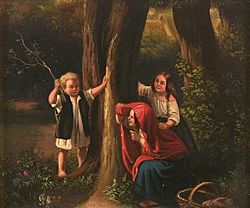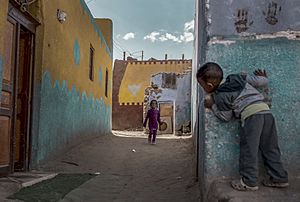Hide-and-seek facts for kids
Hide-and-seek is a fun and classic children's game. It involves at least two players. One player is chosen to be the "seeker." The other players are the "hiders."
The seeker closes their eyes and counts to a set number. While they count, the hiders find places to hide. Once the seeker finishes counting, they call out, "Ready or not, here I come!" Then, the seeker tries to find all the hidden players.
The game can end in different ways. Usually, the seeker finds all the hiders. The first person found becomes the new seeker for the next game. The last person found is the winner of that round.
Another common way to play involves a "home base." The seeker counts at this base. Hiders can try to run back to the home base. If they touch it before the seeker tags them, they are "safe." If the seeker tags a hider before they reach home base, that person becomes the new seeker.
Hide-and-seek is an example of an oral tradition. This means it is often taught by children to other children.
Contents
How to Play Hide-and-Seek
Choosing the Seeker
The game starts by choosing one player to be "it," or the seeker. This can be done by counting rhymes or other fun methods.
Counting and Hiding
The seeker closes their eyes and counts out loud. They usually count to a number like 10, 20, or 100. While the seeker counts, all other players run and find a good hiding spot. Hiders must stay quiet and out of sight.
Finding the Hiders
After counting, the seeker opens their eyes. They then look for the hiders. The seeker might call out a phrase like "Ready or not, here I come!"
Ending the Game
The game usually ends when the seeker finds all the hiders. The first hider found becomes the new seeker. The last hider found wins the round.
Fun Variations of Hide-and-Seek
Many different versions of hide-and-seek are played around the world. They often have unique rules and names.
Sardines
In this version, only one person hides at first. Everyone else tries to find them. When a player finds the hider, they hide with them. More and more people join the hiding spot, making it very crowded, like sardines in a can! The last person to find the group becomes the hider for the next game.
Calling All Hiders
Sometimes, after the first hider is caught, or if no one else can be found, the seeker calls out a special phrase. Common phrases include "Olly olly oxen free" or "All in, All in, Everybody out there all in free." This tells the remaining hiders to come back to the home base.
Catch and Help
In some games, when a hider is found, they then help the seeker. They work together to find the rest of the hidden players. The first person found still becomes the seeker for the next round.
44 Homes (Australia)
In parts of Australia, this game is called "44 Homes." The hiders stay hidden until the seeker spots them. The seeker then chants, "Forty, forty, I see you." Once spotted, the hider must race back to the "home base." If they touch the base before the seeker "tips" (tags) them, they are safe. If they are tagged, they become the new seeker.
Dhappa (North India)
In North India, the game has a special rule. If a hider touches the seeker and says "Dhappa" without being spotted, the seeker must restart counting. The seeker says "I Spies" when they spot a hider. The first hider spotted becomes the seeker for the next game.
Brazilian and Russian Race
In Brazil and Russia, when the seeker spots a hider, both players race. They run to the spot where the seeker was originally counting. The first one to touch that spot wins the game.
Night Games
Sometimes, hide-and-seek is played at night. This can be in a park, a field, or even a house with the lights off. The darkness adds an extra challenge to finding and hiding.
World Championship of Hide-and-Seek
Believe it or not, there is an official "Nascondino World Championship"! "Nascondino" means hide-and-seek in Italian. This is a team-based competition for adults. It started in 2010 in Bergamo, Italy.
The championship happens every summer in Italy. It uses a special outdoor playground with both natural and artificial hiding spots. In 2017, 70 teams from 11 different countries took part in the competition.
See also
 In Spanish: Escondite para niños
In Spanish: Escondite para niños




